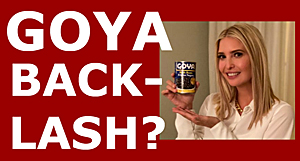


The Permeating Stench of Negative Media Coverage
By Howard Fencl, Hennes Communications
What if you woke up to find that your company had racked up $47 million in negative publicity because of something your CEO said? Certainly, any company prescient enough to have a crisis communication plan packed with doomsday scenarios would include fill-in-the-blank messaging responding to an exec gone rogue.
But $47 million worth? That’s Goya’s motherlode of bad media after the company’s CEO Robert Unanue heaped praise on the President at a White House meeting a month ago. Unanue called the President “a blessed leader,” which sparked an immediate social media firestorm and calls for consumers to boycott Goya products because of the administration’s immigration policy separating Latino families at the southern border and the push to deport DACA program immigrants.
As NBC News reported, “if Goya Brands wanted to elevate brand awareness this summer, it got its wish” (tongue firmly planted in cheek).
How severely did the boycott threat bleed Goya’s bottom line? As my colleague Thom Fladung reported in our last edition of Crisis Management Today, Goya is mum on sales figures, so unless someone leaks numbers from the inside, we may never know.
But we do know there was a whole lot of bad publicity. $47 million worth. Brand analytics consulting company Apex Marketing Group provided this calculation to NBC News. How do you figure it?
Although I’m certain Apex, like everyone doing business on the planet these days, has a proprietary algorithm, the old-fashioned way we do it in PR is with advertising value equivalency, or AVE. If a TV network or local station airs a two-minute story about you, how much would you have to spend to buy the same amount of advertising on that program?
For TV and cable, ad equivalency equals the length of the news report multiplied by the station’s per-minute advertising rate. That can fluctuate depending on the TV day part (time of day the story aired), Nielsen rating of the program, market size and so on. For print coverage, you calculate column inches of the news story and multiply it by the newspaper’s ad rate. The results get sliced and diced – what percentage of that coverage was positive? How much was negative?
It’s a flawed measurement practice that has its fair share of critics, but PR shops still use it to gauge brand awareness and quantify news coverage on PR campaigns against a client’s agency budget.
While Goya’s $47 million debacle doesn’t speak to sales, the figure speaks to the likely negative impact that will linger for the Goya brand. I gleefully trot out a quote from my mentor and friend, Davis Young, who wrote the book on reputation: “…the residual odor of a seriously unfavorable story permeates your business environment for a long, long time.”
If you’ve taken this serious a reputation hit, what can you do about it?
Prepare for a long-term battle. If your CEO decides to take a political stance, it will never be without consequence. Expect blowback. There will always be people who strenuously support a political viewpoint, people who violently oppose it, and people on the fence. It’s rare to win over the opposition – you have to work to keep supporters and convince those on the fence to come on over to your side.
One option for Goya is to lay low, stick to talking about product and be sure to continue cranking out quality food. Goya’s advantage: No matter where you come down on the issue, odds are pretty good that anyone digging around their pantry at this moment will likely find Goya lentils, flour or canned veggies they hungrily stockpiled when coronavirus laid us all low.